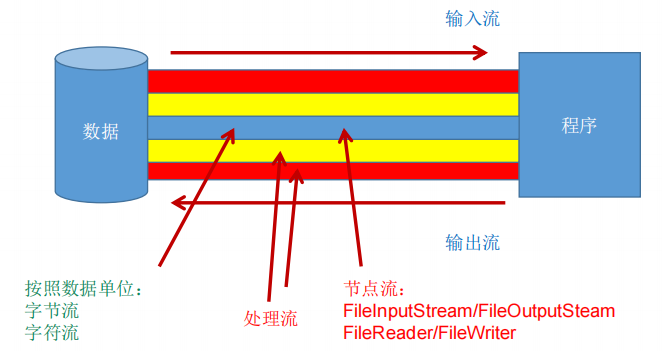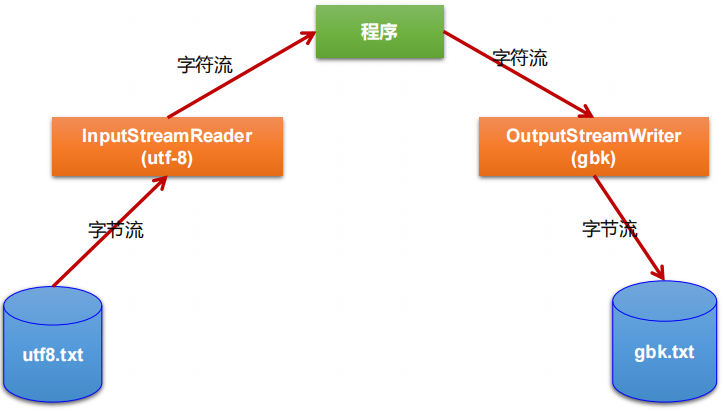一、File类的使用
1. 基本介绍
1)File类的一个对象,代表一个文件或一个文件目录
2)File类声明在java.io包下
3)File类中涉及到关于文件或文件目录的创建、删除、重命名、修改时间、文件大小等方法,并未涉及到写入或读取文件内容的操作。如果需要读取或写入文件内容,必须使用IO流来完成。
4)后续File类的对象常会作为参数传递到流的构造器中,指明读取或写入的”终点”
2. 创建File类的实例
1)File(String filePath)
2)File(String parentPath,String childPath)
以parent为父路径,child为子路径创建File对象
3)File(File parentFile,String childPath)
根据一个父File对象和子文件路径创建File对象
相对路径:相较于某个路径下,指明的路径
绝对路径:包含盘符在内的文件或文件目录的路径
注:File不会判断文件或目录是否存在,只是加载至内存,输出对应的文件路径
// 构造器1File file1 = new File("hello.txt"); // 相对于当前moduleFile file2 = new File("D:\\workspace_idea1\\JavaSenior\\day08\\he.txt");System.out.println(file1); // hello.txtSystem.out.println(file2); // D:\workspace_idea1\JavaSenior\day08\he.txt// 构造器2:File file3 = new File("D:\\workspace_idea1","JavaSenior");System.out.println(file3); //D:\workspace_idea1\JavaSenior// 构造器3:File file4 = new File(file3,"hi.txt");System.out.println(file4); // D:\workspace_idea1\JavaSenior\hi.txt
3. 常用方法一:获取功能
1)public String getAbsolutePath():获取绝对路径
2)public String getPath() :获取路径
3)public String getName() :获取名称
4)public String getParent():获取上层文件目录路径。若无,返回null(相对路径返回null)
5)public long length() :获取文件长度(即:字节数)。不能获取目录的长度。
6)public long lastModified() :获取最后一次的修改时间,毫秒值
File file1 = new File("hello.txt");File file2 = new File("E:\\Java\\JavaSenior\\day08\\hi.txt");System.out.println(file1.getAbsolutePath()); // E:\Java\JavaSenior\day08\hello.txtSystem.out.println(file1.getPath()); // hello.txtSystem.out.println(file1.getName()); // hello.txtSystem.out.println(file1.getParent()); // nullSystem.out.println(file1.length()); // 10System.out.println(new Date(file1.lastModified())); // 2019-02-23System.out.println();System.out.println(file2.getAbsolutePath());// E:\Java\JavaSenior\day08\hi.txtSystem.out.println(file2.getPath()); // E:\Java\JavaSenior\day08\hi.txtSystem.out.println(file2.getName()); // hi.txtSystem.out.println(file2.getParent()); // E:\Java\JavaSenior\day08System.out.println(file2.length()); // 0System.out.println(file2.lastModified()); // 1550911504880
如下的两个方法适用于文件目录:
7)public String[] list() :获取指定目录下的所有文件或者文件目录的名称数组
8)public File[] listFiles() :获取指定目录下的所有文件或者文件目录的File数组
File file = new File("E:\\test");String[] list = file.list();for(String s : list){System.out.println(s); // test1 test2.txt}File[] files = file.listFiles();for(File f : files){System.out.println(f); // E:\test\test1 E:\test\test2.txt}
9)public boolean renameTo(File dest):把文件重命名为指定的文件路径
比如:file1.renameTo(file2)为例。要想保证返回true,需要file1在硬盘中是存在的,且file2不能在硬盘中存在
File file1 = new File("hello.txt");File file2 = new File("D:\\io\\hi.txt");boolean renameTo = file2.renameTo(file1);System.out.println(renameTo);
4. 常用方法二:判断功能
public boolean isDirectory():判断是否是文件目录
public boolean isFile() :判断是否是文件
public boolean exists() :判断是否存在
public boolean canRead() :判断是否可读
public boolean canWrite() :判断是否可写
public boolean isHidden() :判断是否隐藏
File file1 = new File("hello.txt");file1 = new File("hello1.txt");System.out.println(file1.isDirectory());System.out.println(file1.isFile());System.out.println(file1.exists());System.out.println(file1.canRead());System.out.println(file1.canWrite());System.out.println(file1.isHidden());System.out.println();File file2 = new File("d:\\io");file2 = new File("d:\\io1");System.out.println(file2.isDirectory());System.out.println(file2.isFile());System.out.println(file2.exists());System.out.println(file2.canRead());System.out.println(file2.canWrite());System.out.println(file2.isHidden());
5. 常用方法二:创建与删除
5.1 创建文件
public boolean createNewFile() :创建文件。若文件存在,则不创建,返回false
File file1 = new File("hi.txt");if(!file1.exists()){// 文件的创建file1.createNewFile();System.out.println("创建成功");}else{ // 文件存在file1.delete();System.out.println("删除成功");}
5.2 创建文件目录
public boolean mkdir():创建文件目录。如果此文件目录存在,就不创建了。如果此文件目录的上层目录不存在,也不创建
public boolean mkdirs():创建文件目录。如果此文件目录存在,就不创建了。如果上层文件目录不存在,一并创建
注意事项:如果你创建文件或者文件目录没有写盘符路径,那么,默认在项目路径下。
// 文件目录的创建File file1 = new File("d:\\io\\io1\\io3");boolean mkdir = file1.mkdir();if(mkdir){System.out.println("创建成功1");}File file2 = new File("d:\\io\\io1\\io4");boolean mkdir1 = file2.mkdirs();if(mkdir1){System.out.println("创建成功2");}
5.3 删除磁盘中的文件或文件目录
public boolean delete():删除文件或者文件夹
删除注意事项:Java中的删除不走回收站
// 要想删除成功,io4文件目录下不能有子目录或文件File file3 = new File("D:\\io\\io1\\io4");file3 = new File("D:\\io\\io1");System.out.println(file3.delete()); //false
6. File类的使用
File dir1 = new File("D:/IOTest/dir1");if (!dir1.exists()) { // 如果D:/IOTest/dir1不存在,就创建为目录dir1.mkdir();}// 创建以dir1为父目录,名为"dir2"的File对象File dir2 = new File(dir1, "dir2");if (!dir2.exists()) { // 如果还不存在,就创建为目录dir2.mkdirs();}File dir4 = new File(dir1, "dir3/dir4");if (!dir4.exists()) {dir4.mkdirs();}// 创建以dir2为父目录,名为"test.txt"的File对象File file = new File(dir2, "test.txt");if (!file.exists()) { //如果还不存在,就创建为文件file.createNewFile();}
7. 练习题
public class FileDemo {@Testpublic void test1() throws IOException {File file = new File("D:\\io\\io1\\hello.txt");// 创建一个与file同目录下的另外一个文件,文件名为:haha.txtFile destFile = new File(file.getParent(), "haha.txt");boolean newFile = destFile.createNewFile();if(newFile){System.out.println("创建成功!");}}}
/*** 课后练习2:判断指定目录下是否有后缀名为.jpg的文件,如果有,就输出该文件名称*/public class FindJPGFileTest {@Testpublic void test1(){File srcFile = new File("d:\\code");String[] fileNames = srcFile.list();for(String fileName : fileNames){if(fileName.endsWith(".jpg")){System.out.println(fileName);}}}@Testpublic void test2(){File srcFile = new File("d:\\code");File[] listFiles = srcFile.listFiles();for(File file : listFiles){if(file.getName().endsWith(".jpg")){System.out.println(file.getAbsolutePath());}}}/** File类提供了两个文件过滤器方法* public String[] list(FilenameFilter filter)* public File[] listFiles(FileFilter filter)*/@Testpublic void test3(){File srcFile = new File("d:\\code");File[] subFiles = srcFile.listFiles(new FilenameFilter() {@Overridepublic boolean accept(File dir, String name) {return name.endsWith(".jpg");}});for(File file : subFiles){System.out.println(file.getAbsolutePath());}}}
/*** 课后练习3. 遍历指定目录所有文件名称,包括子文件目录中的文件拓展1:并计算指定目录占用空间的大小拓展2:删除指定文件目录及其下的所有文件*/public class ListFilesTest {public static void main(String[] args) {// 递归:文件目录/** 打印出指定目录所有文件名称,包括子文件目录中的文件 */// 1.创建目录对象File dir = new File("E:\\teach\\01_javaSE\\_尚硅谷Java编程语言\\3_软件");// 2.打印目录的子文件printSubFile(dir);}public static void printSubFile(File dir) {// 打印目录的子文件File[] subfiles = dir.listFiles();for (File f : subfiles) {if (f.isDirectory()) {// 文件目录printSubFile(f);} else {// 文件System.out.println(f.getAbsolutePath());}}}// 方式二:循环实现// 列出file目录的下级内容,仅列出一级的话// 使用File类的String[] list()比较简单public void listSubFiles(File file) {if (file.isDirectory()) {String[] all = file.list();for (String s : all) {System.out.println(s);}} else {System.out.println(file + "是文件!");}}// 列出file目录的下级,如果它的下级还是目录,接着列出下级的下级,依次类推// 建议使用File类的File[] listFiles()public void listAllSubFiles(File file) {if (file.isFile()) {System.out.println(file);} else {File[] all = file.listFiles();// 如果all[i]是文件,直接打印// 如果all[i]是目录,接着再获取它的下一级for (File f : all) {listAllSubFiles(f);// 递归调用:自己调用自己就叫递归}}}// 拓展1:求指定目录所在空间的大小// 求任意一个目录的总大小public long getDirectorySize(File file) {// file是文件,那么直接返回file.length()// file是目录,把它的下一级的所有大小加起来就是它的总大小long size = 0;if (file.isFile()) {size += file.length();} else {File[] all = file.listFiles();// 获取file的下一级// 累加all[i]的大小for (File f : all) {size += getDirectorySize(f);// f的大小;}}return size;}// 拓展2:删除指定的目录public void deleteDirectory(File file) {// 如果file是文件,直接delete// 如果file是目录,先把它的下一级干掉,然后删除自己if (file.isDirectory()) {File[] all = file.listFiles();// 循环删除的是file的下一级for (File f : all) {// f代表file的每一个下级deleteDirectory(f);}}// 删除自己file.delete();}}
二、IO流原理及流的分类
1. Java IO原理
1)I/O是Input/Output的缩写,I/O技术是非常实用的技术,用于处理设备之间的数据传输。如读/写文件,网络通讯等
2)Java程序中,对于数据的输入/输出操作以“流(stream)”的方式进行
3)java.io包下提供了各种“流”类和接口,用以获取不同种类的数据,并通过标准的方法输入或输出数据
4)输入input:读取外部数据(磁盘、光盘等存储设备的数据)到程序(内存)中
5)输出output:将程序(内存)数据输出到磁盘、光盘等存储设备中
2. 流的分类
1)按操作数据单位不同分为:字节流(8 bit)(图片、视频等非文本),字符流(16 bit)(文本)
2)按数据流的流向不同分为:输入流,输出流
3)按流的角色的不同分为:节点流,处理流
节点流:直接从数据源或目的地读写数据
处理流:不直接连接到数据源或目的地,而是“连接”在已存在的流(节点流或处理流)之上,通过对数据的处理为程序提供更为强大的读写功能
3. IO流体系
三、文件流的使用
文件流:属于节点流
FileInputStream
FileOutputStream
FileReader
FileWriter
1、FileReader、FileWriter访问文本文件
1.1 FileReader读取数据
FileReader fr = null;try {// 1.实例化File类的对象,指明要操作的文件File file = new File("hello.txt");//相较于当前Module// 2.提供具体的流fr = new FileReader(file);// 3.数据的读入// read():从输入流中读取数据的下一个字节。// 返回0到255范围内的int字节值。如果达到文件末尾,返回-1int data;while((data = fr.read()) != -1){System.out.print((char)data);}} catch (IOException e) {e.printStackTrace();} finally {// 4.流的关闭操作if(fr != null){try {fr.close();} catch (IOException e) {e.printStackTrace();}}}说明点:1. read()的理解:返回读入的一个字符。如果达到文件末尾,返回-12. 异常的处理:为了保证流资源一定可以执行关闭操作。需要使用try-catch-finally处理3. 读入的文件一定要存在,否则就会报FileNotFoundException。
对read()操作升级:使用read的重载方法
FileReader fr = null;try {// 1.File类的实例化File file = new File("hello.txt");// 2.FileReader流的实例化fr = new FileReader(file);// 3.读入的操作// read(char[] cbuf):从此输入流中将最多b.length个字节的数据读入一个byte数组中。// 如果达到文件末尾,返回-1char[] cbuf = new char[5];int len;while((len = fr.read(cbuf)) != -1){// 方式一:// 错误的写法// for(int i = 0;i < cbuf.length;i++){// System.out.print(cbuf[i]); //输出:helloworld123ld// }// 正确的写法// for(int i = 0;i < len;i++){// System.out.print(cbuf[i]); //输出:helloworld123// }// 方式二:// 错误的写法,对应着方式一的错误的写法// String str = new String(cbuf);// System.out.print(str);// 正确的写法String str = new String(cbuf,0,len);System.out.print(str);}} catch (IOException e) {e.printStackTrace();} finally {if(fr != null){// 4.资源的关闭try {fr.close();} catch (IOException e) {e.printStackTrace();}}}
1.2 FileWriter写入数据
FileWriter fw = null;try {//1.提供File类的对象,指明写出到的文件File file = new File("hello1.txt");//2.提供FileWriter的对象,用于数据的写出fw = new FileWriter(file,false);//3.写出的操作fw.write("I have a dream!\n");fw.write("you need to have a dream!");} catch (IOException e) {e.printStackTrace();} finally {//4.流资源的关闭if(fw != null){try {fw.close();} catch (IOException e) {e.printStackTrace();}}}说明:1. 输出操作,对应的File可以不存在的。并不会报异常2.File对应的硬盘中的文件如果不存在,在输出的过程中,会自动创建此文件。3.File对应的硬盘中的文件如果存在:如果流使用的构造器是:FileWriter(file,false) / FileWriter(file):对原有文件的覆盖如果流使用的构造器是:FileWriter(file,true):不会对原有文件覆盖,而是在原有文件基础上追加内容
1.3 文本文件的复制
FileReader fr = null;FileWriter fw = null;try {// 1.创建File类的对象,指明读入和写出的文件File srcFile = new File("hello.txt");File destFile = new File("hello2.txt");// 不能使用字符流来处理图片等字节数据// File srcFile = new File("爱情与友情.jpg");// File destFile = new File("爱情与友情1.jpg");// 2.创建输入流和输出流的对象fr = new FileReader(srcFile);fw = new FileWriter(destFile);// 3.数据的读入和写出操作char[] cbuf = new char[5];int len; // 记录每次读入到cbuf数组中的字符的个数while((len = fr.read(cbuf)) != -1){// 每次写出len个字符fw.write(cbuf,0,len);}} catch (IOException e) {e.printStackTrace();} finally {// 4.关闭流资源try {if(fw != null)fw.close();} catch (IOException e) {e.printStackTrace();}try {if(fr != null)fr.close();} catch (IOException e) {e.printStackTrace();}}
2、FileInputStream、FileOutputStream访问非文本文件
FileInputStream fis = null;FileOutputStream fos = null;try {// 1. 造文件File srcFile = new File("爱情与友情.jpg");File destFile = new File("爱情与友情2.jpg");// 2.造流fis = new FileInputStream(srcFile);fos = new FileOutputStream(destFile);// 3.复制的过程byte[] buffer = new byte[5];int len;while((len = fis.read(buffer)) != -1){fos.write(buffer,0,len);}} catch (IOException e) {e.printStackTrace();} finally {// 4.关闭资源fos.close();fis.close();}
结论:
- 对于文本文件(.txt、.java、.c、.cpp),使用字符流处理
- 对于非文本文件(.jpg、.mp3、.mp4、.avi、.doc、.ppt、…),使用字节流处理
可以采用字节流处理文本文件单纯的复制操作。如果处理文本文件的读取操作,会出现乱码
四、缓冲流的使用
1)缓冲流:处理流的一种
BufferedInputStream
BufferedOutputStream
BufferedReader
BufferedWriter
2)作用:提供流的读取、写入的速度
提高读写速度的原因:内部提供了一个缓冲区
3)处理流,就是“套接”在已有的流(节点流/处理流)的基础上。不能直接作用在文件上1、实现非文本文件的复制
BufferedInputStream bis = null;BufferedOutputStream bos = null;try {// 1.造文件File srcFile = new File("爱情与友情.jpg");File destFile = new File("爱情与友情3.jpg");// 2.造流// 2.1 造节点流FileInputStream fis = new FileInputStream((srcFile));FileOutputStream fos = new FileOutputStream(destFile);// 2.2 造缓冲流bis = new BufferedInputStream(fis);bos = new BufferedOutputStream(fos);// 3.复制的细节:读取、写入byte[] buffer = new byte[10]; // 创建一个临时存放数据的数组int len;while((len = bis.read(buffer)) != -1){bos.write(buffer,0,len); // write的同时会自动刷新缓冲区// bos.flush(); //刷新缓冲区}} catch (IOException e) {e.printStackTrace();} finally {// 4.资源关闭// 要求:先关闭外层的流,再关闭内层的流if(bos != null){try {bos.close();} catch (IOException e) {e.printStackTrace();}}if(bis != null){try {bis.close();} catch (IOException e) {e.printStackTrace();}}// 说明:关闭外层流的同时,内层流也会自动的进行关闭。关于内层流的关闭,我们可以省略.// fos.close();// fis.close();}
2、实现文本文件的复制
BufferedReader br = null;BufferedWriter bw = null;try {// 创建文件和相应的流br = new BufferedReader(new FileReader(new File("dbcp.txt")));bw = new BufferedWriter(new FileWriter(new File("dbcp1.txt")));// 读写操作// 方式一:使用char[]数组// char[] cbuf = new char[1024];// int len;// while((len = br.read(cbuf)) != -1){// bw.write(cbuf,0,len);// //bw.flush();// }// 方式二:使用StringString data;while((data = br.readLine()) != null){// 方法一:// bw.write(data + "\n"); // data中不包含换行符// 方法二:bw.write(data); // data中不包含换行符bw.newLine(); // 提供换行的操作}} catch (IOException e) {e.printStackTrace();} finally {// 关闭资源bw.close();br.close();}
3、练习题:图片的加解密
FileInputStream fis = null;FileOutputStream fos = null;try {fis = new FileInputStream("爱情与友情.jpg");fos = new FileOutputStream("爱情与友情secret1.jpg");byte[] buffer = new byte[20];int len;while ((len = fis.read(buffer)) != -1) {//字节数组进行修改//错误的//for(byte b : buffer){// b = (byte) (b ^ 5);//}//正确的for (int i = 0; i < len; i++) {buffer[i] = (byte) (buffer[i] ^ 5);}fos.write(buffer, 0, len);}} catch (IOException e) {e.printStackTrace();} finally {// 4.关流fos.close();fis.close();}
FileInputStream fis = null;FileOutputStream fos = null;try {fis = new FileInputStream("爱情与友情secret.jpg");fos = new FileOutputStream("爱情与友情4.jpg");byte[] buffer = new byte[20];int len;while ((len = fis.read(buffer)) != -1) {// 字节数组进行修改// 错误的// for(byte b : buffer){// b = (byte) (b ^ 5);// }// 正确的for (int i = 0; i < len; i++) {buffer[i] = (byte) (buffer[i] ^ 5); // 两次异或操作,回到原数据}fos.write(buffer, 0, len);}} catch (IOException e) {e.printStackTrace();} finally {if (fos != null) {try {fos.close();} catch (IOException e) {e.printStackTrace();}}if (fis != null) {try {fis.close();} catch (IOException e) {e.printStackTrace();}}}
4、练习题:获取文本上字符出现的次数,把数据写入文件
FileReader fr = null;BufferedWriter bw = null;try {// 1.创建Map集合Map<Character, Integer> map = new HashMap<Character, Integer>();// 2.遍历每一个字符,每一个字符出现的次数放到map中fr = new FileReader("dbcp.txt");int c = 0;while ((c = fr.read()) != -1) {//int 还原 charchar ch = (char) c;// 判断char是否在map中第一次出现if (map.get(ch) == null) {map.put(ch, 1);} else {map.put(ch, map.get(ch) + 1);}}// 3.把map中数据存在文件count.txt// 3.1 创建Writerbw = new BufferedWriter(new FileWriter("wordcount.txt"));// 3.2 遍历map,再写入数据Set<Map.Entry<Character, Integer>> entrySet = map.entrySet();for (Map.Entry<Character, Integer> entry : entrySet) {switch (entry.getKey()) {case ' ':bw.write("空格=" + entry.getValue());break;case '\t':bw.write("tab键=" + entry.getValue());break;case '\r':bw.write("回车=" + entry.getValue());break;case '\n':bw.write("换行=" + entry.getValue());break;default:bw.write(entry.getKey() + "=" + entry.getValue());break;}bw.newLine();}} catch (IOException e) {e.printStackTrace();} finally {// 4.关流fr.close();bw.close();}
五、转换流的使用
1)转换流:属于字符流、处理流
InputStreamReader:将一个字节的输入流转换为字符的输入流
OutputStreamWriter:将一个字符的输出流转换为字节的输出流
2)作用:提供字节流与字符流之间的转换。很多时候我们使用转换流来处理文件乱码问题。实现编码和
解码的功能
3)解码:字节、字节数组 —-> 字符数组、字符串
编码:字符数组、字符串 —-> 字节、字节数组
4)字符集
ASCII:美国标准信息交换码。用一个字节的7位可以表示
ISO8859-1:拉丁码表。欧洲码表。用一个字节的8位表示
GB2312:中国的中文编码表。最多两个字节编码所有字符
GBK:中国的中文编码表升级,融合了更多的中文文字符号。最多两个字节编码
Unicode:国际标准码,融合了目前人类使用的所有字符。为每个字符分配唯一的字符码。所有的文字都用两个字节来表示
UTF-8:变长的编码方式,可用1-4个字节来表示一个字符。
5)InputStreamReader的使用,实现字节的输入流到字符的输入流的转换 ```java FileInputStream fis = new FileInputStream(“dbcp.txt”);
// InputStreamReader isr = new InputStreamReader(fis); // 使用系统默认的字符集 // 参数2指明了字符集,具体使用哪个字符集,取决于文件dbcp.txt保存时使用的字符集 InputStreamReader isr = new InputStreamReader(fis,”UTF-8”);
char[] cbuf = new char[20]; int len; while((len = isr.read(cbuf)) != -1){ String str = new String(cbuf,0,len); System.out.print(str); } isr.close();
6)综合使用InputStreamReader和OutputStreamWriter```java// 1.造文件、造流File file1 = new File("dbcp.txt");File file2 = new File("dbcp_gbk.txt");FileInputStream fis = new FileInputStream(file1);FileOutputStream fos = new FileOutputStream(file2);InputStreamReader isr = new InputStreamReader(fis,"utf-8");OutputStreamWriter osw = new OutputStreamWriter(fos,"gbk");// 2.读写过程char[] cbuf = new char[20];int len;while((len = isr.read(cbuf)) != -1){osw.write(cbuf,0,len);}// 3.关闭资源isr.close();osw.close();
六、标准输入、输出流(了解)
1)System.in:标准的输入流,默认从键盘输入(字节流)
System.out:标准的输出流,默认从控制台输出
2)System类的setIn(InputStream is) / setOut(PrintStream ps)方式重新指定输入和输出的流
3)练习:
从键盘输入字符串,要求将读取到的整行字符串转成大写输出。然后继续进行输入操作,直至当输入“e”或者“exit”时,退出程序。
方法一:使用Scanner实现,调用next()返回一个字符串
方法二:使用System.in实现。System.in —-> 转换流 —-> BufferedReader的readLine()
BufferedReader br = null;try {InputStreamReader isr = new InputStreamReader(System.in);br = new BufferedReader(isr);while (true) {System.out.println("请输入字符串:");String data = br.readLine();if ("e".equalsIgnoreCase(data) || "exit".equalsIgnoreCase(data)) {System.out.println("程序结束");break;}String upperCase = data.toUpperCase();System.out.println(upperCase);}} catch (IOException e) {e.printStackTrace();} finally {br.close();}
七、打印流(了解)
1)实现将基本数据类型的数据格式转化为字符串输出
2)打印流:PrintStream和PrintWriter
- 提供了一系列重载的print()和println()方法,用于多种数据类型的输出
- PrintStream和PrintWriter的输出不会抛出IOException异常
- PrintStream和PrintWriter有自动flush功能
- PrintStream 打印的所有字符都使用平台的默认字符编码转换为字节。在需要写入字符而不是写入字节的情况下,应该使用 PrintWriter 类。
- System.out返回的是PrintStream的实例
PrintStream ps = null;try {FileOutputStream fos = new FileOutputStream(new File("D:\\IO\\text.txt"));// 创建打印输出流,设置为自动刷新模式(写入换行符或字节 '\n' 时都会刷新输出缓冲区)ps = new PrintStream(fos, true);if (ps != null) { // 把标准输出流(控制台输出)改成文件System.setOut(ps);}for (int i = 0; i <= 255; i++) { // 输出ASCII字符System.out.print((char) i);if (i % 50 == 0) { // 每50个数据一行System.out.println(); // 换行}}} catch (FileNotFoundException e) {e.printStackTrace();} finally {ps.close();}
八、数据流(了解)
1)DataInputStream 和 DataOutputStream
2)作用:用于读取或写出基本数据类型的变量或字符串
3)将内存中的字符串、基本数据类型的变量写出到文件中
4)将文件中存储的基本数据类型变量和字符串读取到内存中,保存在变量中// 1.造文件、造流DataOutputStream dos = new DataOutputStream(new FileOutputStream("data.txt"));// 2.写入过程dos.writeUTF("刘建辰");dos.flush(); //刷新操作,将内存中的数据写入文件dos.writeInt(23);dos.flush();dos.writeBoolean(true);dos.flush();// 3.关流dos.close();
5)注意点:读取不同类型的数据的顺序要与当初写入文件时,保存的数据的顺序一致! ```java // 1.造文件、造流 DataInputStream dis = new DataInputStream(new FileInputStream(“data.txt”)); // 2.读取过程 String name = dis.readUTF(); int age = dis.readInt(); boolean isMale = dis.readBoolean();
System.out.println(“name = “ + name); System.out.println(“age = “ + age); System.out.println(“isMale = “ + isMale); // 3.关流 dis.close();
<a name="sV2mV"></a># 九、对象流<a name="Yotcf"></a>## 1. 基本概念- ObjectInputStream和OjbectOutputSteam- 用于存储和读取基本数据类型数据或对象的处理流。它的强大之处就是可以把Java中的对象写入到数据源中,也能把对象从数据源中还原回来- 序列化:用ObjectOutputStream类保存基本类型数据或对象的机制- 反序列化:用ObjectInputStream类读取基本类型数据或对象的机制- ObjectOutputStream和ObjectInputStream不能序列化static和transient修饰的成员变量<a name="XFbNw"></a>## 2. 对象的序列化1)对象序列化机制允许把内存中的Java对象转换成平台无关的二进制流,从而允许把这种二进制流持久地保存在磁盘上,或通过网络将这种二进制流传输到另一个网络节点。//当其它程序获取了这种二进制流,就可以恢复成原来的Java对象<br />2)序列化的好处在于可将任何实现了Serializable接口的对象转化为字节数据,使其在保存和传输时可被还原<br />3)如果需要让某个对象支持序列化机制,则必须让对象所属的类及其属性是可序列化的,为了让某个类是可序列化的,该类必须实现如下两个接口之一。否则,会抛出NotSerializableException异常Serializable、Externalizable<br />4)凡是实现Serializable接口的类都有一个表示序列化版本标识符的静态变量:private static final long serialVersionUID;serialVersionUID用来表明类的不同版本间的兼容性。简言之,其目的是以序列化对象进行版本控制,有关各版本反序列化时是否兼容。如果类没有显示定义这个静态常量,它的值是Java运行时环境根据类的内部细节自动生成的。若类的实例变量做了修改,serialVersionUID可能发生变化。故建议,显式声明。<br />5)简单来说,Java的序列化机制是通过在运行时判断类的serialVersionUID来验证版本一致性的。在进行反序列化时,JVM会把传来的字节流中的serialVersionUID与本地相应实体类的serialVersionUID进行比较,如果相同就认为是一致的,可以进行反序列化,否则就会出现序列化版本不一致的异常。(InvalidCastException)<br />6)序列化过程:将内存中的java对象保存到磁盘中或通过网络传输出去,使用ObjectOutputStream实现ObjectOutputStream oos = null;```javaObjectOutputStream oos = null;try {//1.造文件、造流oos = new ObjectOutputStream(new FileOutputStream("object.dat"));//2.写入过程oos.writeObject(new String("我爱北京天安门"));oos.flush(); //刷新操作oos.writeObject(new Person("王铭",23));oos.flush();oos.writeObject(new Person("张学良",23,1001,new Account(5000)));oos.flush();//3.关流oos.close();}
7)反序列化:将磁盘文件中的对象还原为内存中的一个java对象,使用ObjectInputStream来实现
ObjectInputStream ois = null;try {ois = new ObjectInputStream(new FileInputStream("object.dat"));Object obj = ois.readObject();String str = (String) obj;Person p = (Person) ois.readObject();Person p1 = (Person) ois.readObject();System.out.println(str);System.out.println(p);System.out.println(p1);} catch (IOException e) {e.printStackTrace();} catch (ClassNotFoundException e) {e.printStackTrace();} finally {ois.close();}
3. 自定义类实现序列化
Person需要满足如下的要求,方可序列化
1)需要实现接口:Serializable
2)当前类提供一个全局常量:serialVersionUID
3)除了当前Person类需要实现Serializable接口之外,还必须保证其内部所有属性也必须是可序列化的。(默认情况下,基本数据类型可序列化)
@ToString@Data@AllArgsConstructor@NoArgsConstructorpublic class Person implements Serializable{public static final long serialVersionUID = 475463534532L;private String name;private int age;private int id;private Account acct;}@ToString@Data@AllArgsConstructor@NoArgsConstructorclass Account implements Serializable{public static final long serialVersionUID = 4754534532L;private double balance;}
十、随机存取文件流(RandomAccessFile 类)
1、RandomAccessFile声明在java.io包下,但直接继承于java.lang.Object类。并且它实现了DataInput、DataOutput这两个接口,也就意味着这个类既可以读也可以写。
2、RandomAccessFile类支持 “随机访问” 的方式,程序可以直接跳到文件的任意地方来读、写文件。支持只访问文件的部分内容;可以向已存在的文件后追加内容
3、RandomAccessFile对象包含一个记录指针,用以标示当前读写处的位置。RandomAccessFile类对象可以自由移动记录指针:
- long getFilePointer():获取文件记录指针的当前位置
- void seek(long pos):将文件记录指针定位到pos位置
4、构造器
- public RandomAccessFile(File file, String mode)
- public RandomAccessFile(String name, String mode) l
5、创建RandomAccessFile类实例需要指定一个mode参数,该参数指定RandomAccessFile的访问模式:
- r:以只读方式打开
- rw:打开以便读取和写入
- rwd:打开以便读取和写入;同步文件内容的更新
- rws:打开以便读取和写入;同步文件内容和元数据的更新
6、如果模式为只读r。则不会创建文件,而是会去读取一个已经存在的文件,如果读取的文件不存在则会出现异常
7、如果模式为rw读写。如果文件不存在则会去创建文件,如果存在则不会创建,并会对原有文件内容进行覆盖(默认情况下,从头覆盖)
RandomAccessFile raf1 = null;RandomAccessFile raf2 = null;try {//1.造文件、造流raf1 = new RandomAccessFile(new File("爱情与友情.jpg"),"r");raf2 = new RandomAccessFile(new File("爱情与友情1.jpg"),"rw");//2.读取与写入过程byte[] buffer = new byte[1024];int len;while((len = raf1.read(buffer)) != -1){raf2.write(buffer,0,len);}} catch (IOException e) {e.printStackTrace();} finally {//3.关流raf1.close();raf2.close();}
8、使用RandomAccessFile实现数据的插入效果
RandomAccessFile raf1 = new RandomAccessFile("hello.txt","rw");raf1.seek(3);// 将指针调到角标为3的位置// 保存指针3后面的所有数据到StringBuilder中StringBuilder builder = new StringBuilder((int) new File("hello.txt").length());byte[] buffer = new byte[20];int len;while((len = raf1.read(buffer)) != -1){builder.append(new String(buffer,0,len)) ;}// 调回指针,写入“xyz”raf1.seek(3);raf1.write("xyz".getBytes());//将StringBuilder中的数据写入到文件中raf1.write(builder.toString().getBytes());raf1.close();
补充:使用第三方jar包实现数据读写
import org.apache.commons.io.FileUtils;import java.io.File;import java.io.IOException;File srcFile = new File("day10\\爱情与友情.jpg");File destFile = new File("day10\\爱情与友情2.jpg");try {FileUtils.copyFile(srcFile,destFile);} catch (IOException e) {e.printStackTrace();}




